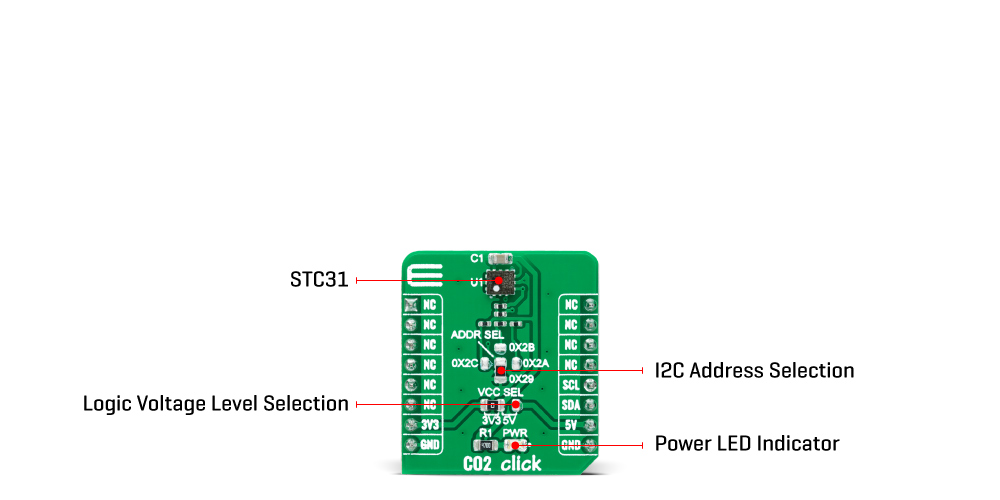






Overview
The CO2 Click Board™ is a compact add-on board that contains Sensirion’s miniature CO₂ sensor. This board features the STC31, a gas concentration sensor designed for high-volume applications. The STC31 utilizes a revolutionized thermal conductivity measurement principle, which results in superior repeatability and long-term stability. The outstanding performance of these sensors is based on Sensirion’s patented CMOSens® sensor technology, which combines the sensor element, signal processing, and digital calibration on a small CMOS chip. It features a digital I2C interface, which makes it easy to connect directly to MCU. This Click board™ represents an ideal choice for health, environmental, industrial, residential monitoring of high CO2 concentrations and applications where reliability is crucial.
The CO2 Click Board™ is supported by a mikroSDK compliant library, which includes functions that simplify software development. This Click board™ comes as a fully tested product, ready to be used on a system equipped with the mikroBUS™ socket.
Downloads
How Does The CO2 Click Board™ Work?
The CO2 Click Board™ as its foundation uses the STC31, a gas concentration sensor for high range, accurate CO₂ measurements designed for high-volume applications from Sensirion. The STC31 is based on a revolutionized thermal conductivity measurement principle, which results in superior repeatability and long-term stability. By relying on the thermal conductivity technology, the sensor offers an ultra-low power consumption, making the STC31 the perfect choice for applications where reliability is key.

The accuracy of the STC31 is 0.5 vol%, and ±3% of the measured value, while the sensor response time is faster than 1 second. The outstanding performance of these sensors is based on Sensirion's patented CMOSens® Technology, which combines the sensor element, signal processing, and digital calibration on a small CMOS chip. The well-proven CMOSens® Technology represents the ideal choice for demanding and cost-sensitive OEM applications.
The CO2 Click Board™ communicates with MCU using the standard I2C 2-Wire interface to read data and configure settings, supporting Standard Mode operation with a clock frequency up to 100kHz, Fast Mode up to 400kHz, and Fast Mode Plus up to 1MHz. Besides, it also allows the choice of the three least significant bits of its I2C slave address by positioning the SMD jumper labelled as ADDR SEL to an appropriate position providing the user with a choice of 4 I2C Slave addresses.
The CO2 Click Board™ can operate with both 3.3V and 5V logic voltage levels selected via the VCC SEL jumper. This way, it is allowed for both 3.3V and 5V capable MCUs to use the I2C communication lines properly. However, the Click board™ comes equipped with a library containing easy-to-use functions and an example code that can be used, as a reference, for further development.
SPECIFICATIONS
| Type | Gas |
| Applications | The CO2 Click Board™ be used for health, environmental, industrial, residential monitoring of high CO₂ concentrations and applications where reliability is crucial |
| On-board modules | STC31 - gas concentration sensor for high range, accurate CO₂ measurements designed for high-volume applications from Sensirion |
| Key Features | Low power consumption, high reliability and long-term stability, best signal-to-noise ratio, industry-proven technology with a track record of more than 15 years, high process capability, and more |
| Interface | I2C |
| Compatibility | mikroBUS |
| Click board size | S (28.6 x 25.4 mm) |
| Input Voltage | 3.3V or 5V |
PINOUT DIAGRAM
This table shows how the pinout of the CO2 Click Board™ corresponds to the pinout on the mikroBUS™ socket (the latter shown in the two middle columns).
| Notes | Pin |  |
Pin | Notes | |||
|---|---|---|---|---|---|---|---|
| NC | 1 | AN | PWM | 16 | NC | ||
| NC | 2 | RST | INT | 15 | NC | ||
| NC | 3 | CS | RX | 14 | NC | ||
| NC | 4 | SCK | TX | 13 | NC | ||
| NC | 5 | MISO | SCL | 12 | SCL | I2C Clock | |
| NC | 6 | MOSI | SDA | 11 | SDA | I2C Data | |
| Power Supply | 3.3V | 7 | 3.3V | 5V | 10 | 5V | Power Supply |
| Ground | GND | 8 | GND | GND | 9 | GND | Ground |
ONBOARD SETTINGS AND INDICATORS
| Label | Name | Default | Description |
|---|---|---|---|
| LD1 | PWR | - | Power LED Indicator |
| JP1 | VCC SEL | Left | Logic Level Voltage Selection 3V3/5V: Left position 3V3, Right position 5V |
| JP2 | ADDR SEL | Lower | I2C Address Selection: Left position 0x2C, Right position 0x2A, Upper position 0x2B, Lower position 0x29 |
CO2 CLICK ELECTRICAL SPECIFICATIONS
| Description | Min | Typ | Max | Unit |
|---|---|---|---|---|
| Supply Voltage | 3.3 | - | 5 | V |
| Selectable Measurement Range (N2 / Air) | 0 | - | 25/100 | vol% |
| Accuracy | - | ±0.5 | - | % |
| Resolution | - | 16 | - | bit |
| Operating Temperature Range | -20 | +25 | +85 | °C |
| General Information | |
|---|---|
Part Number (SKU) |
MIKROE-4725
|
Manufacturer |
|
| Physical and Mechanical | |
Weight |
0.02 kg
|
| Other | |
Country of Origin |
|
HS Code Customs Tariff code
|
|
EAN |
8606027389542
|
Warranty |
|
Frequently Asked Questions
Have a Question?
Be the first to ask a question about this.







